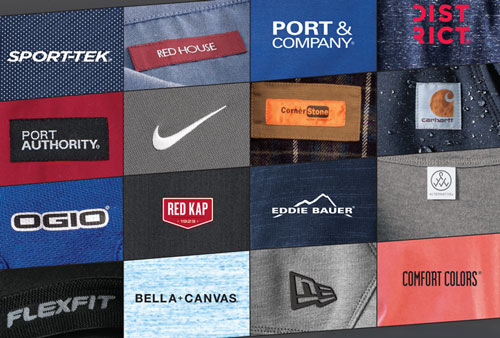Understanding Fabric Weaves and Textures in Branded Clothing
Understanding Fabric Weaves and Textures in Branded Clothing
Blog Article
Recognizing Clothing: The Relevance of Textile Options in Your Wardrobe
The choice of textile in clothes plays a pivotal duty in both looks and performance. Different materials offer varying degrees of breathability, convenience, and longevity, straight affecting the wearer's experience. Recognizing these subtleties can boost one's wardrobe markedly. Yet, numerous overlook how these options can affect not simply personal design, however also sustainability. What textile decisions could redefine your wardrobe and straighten it with both style and responsibility?
The Function of Textile in Fashion and Performance

Typical Textile Types and Their Features
When selecting apparel, comprehending the features of common material types is important for making educated selections. Cotton, a widely-used all-natural fiber, is recognized for its flexibility, breathability, and softness, making it ideal for sportswear and everyday garments. Bed linen, one more natural option, boasts exceptional moisture-wicking homes and a distinctive appearance, perfect for cozy climates.Wool, usually favored for its warmth and resilience, varies in fineness; merino wool is soft versus the skin, while coarser kinds are used for outerwear. Artificial textiles like polyester and nylon offer sturdiness and resistance to creases, making them preferred for activewear and travel garments. Blends, which combine synthetic and all-natural fibers, can improve performance while maintaining convenience. By acknowledging these fabric qualities, individuals can choose clothing that straightens with their way of life and aesthetic preferences.
Breathability and Convenience: Selecting the Right Fabrics for Various Climates
Choosing the best fabrics for various climates can significantly improve comfort and overall wearability. Breathable products are important in warm climates, as they allow air flow and dampness dissipation. Fabrics such as cotton, linen, and moisture-wicking synthetics effectively draw sweat far from the body, keeping the user cool and completely dry. Conversely, in chillier environments, thicker fabrics like wool or fleece offer insulation while retaining breathability, guaranteeing warmth without overheating.Additionally, the selection of material weight plays a crucial role; light-weight fabrics are more suitable for summer season, whereas much heavier alternatives are suited for winter months wear. Recognizing the unique properties of each fabric makes it possible for individuals to dress suitably for differing climate condition. Inevitably, choosing breathable and comfy materials customized to certain environments can substantially improve everyday convenience and improve the total experience of putting on clothes.
Toughness and Treatment: Exactly How Textile Impacts Long Life of Your Closet
Selecting the ideal products can substantially affect the resilience and treatment demands of a wardrobe. Fabrics such as cotton and polyester are known for their resilience and ease of maintenance, making them perfect for everyday wear. In comparison, delicate materials like silk and lace call for more cautious handling and specialized cleansing methods, which can raise the time and initiative needed for care. Branded Clothing.Durability is additionally affected by the textile's weave and finish; firmly woven fabrics often tend to resist damage far better than loosely woven options. Additionally, artificial blends typically give enhanced resilience, combining the very best high qualities of multiple fibers.Understanding the care guidelines for each material is crucial, as incorrect cleaning or click here to read drying can cause premature wear. Eventually, choosing sturdy materials can lead check out this site to a longer-lasting closet, reducing the regularity of substitutes and adding to a much more sustainable fashion option
The Effect of Textile on Fit and Silhouette

Sustainable Material Choices: Making Eco-Friendly Choices
The effect of fabric prolongs beyond fit and silhouette to encompass environmental aspects, prompting an expanding rate of interest in lasting textile choices. Green fabrics, such as organic cotton, hemp, and Tencel, are gaining grip among customers that prioritize sustainability in their closets. These products are often generated with less chemicals and water, lowering their ecological footprint.Additionally, recycled textiles, made from post-consumer waste, provide an ingenious solution to the fabric industry's air pollution issue. Brands progressively embrace transparency in their sourcing methods, permitting consumers to make educated decisions concerning their purchases.Choosing lasting materials not just supports honest techniques however additionally motivates the apparel industry to adopt more responsible manufacturing techniques. As recognition of ecological problems climbs, individuals are advised to review the lasting impact of their material choices, cultivating a motion towards an extra ecologically mindful and lasting technique to style.
Raising Design: Exactly How Textile Can Change an Attire
While numerous might concentrate on color and cut when selecting a clothing, the selection of textile plays a necessary function in elevating design and enhancing general appearance. Various products convey distinctive state of minds and messages; for instance, silk exhibits luxury and elegance, while denim offers a casual, relaxed ambiance. review The texture and drape of a material can drastically alter the shape, with structured materials supplying a refined appearance and softer ones developing a much more fluid, loosened up aesthetic.Moreover, the weight of the material affects wearability throughout seasons. Lightweight fabrics like bed linen and cotton are excellent for summertime, while heavier products such as wool and velvet give heat and sophistication in cooler months. Recognizing material residential properties, such as breathability and stretch, additionally encourages people to make enlightened choices that improve convenience without endangering design. Inevitably, the appropriate textile can transform a clothing from regular to remarkable, making it an essential consideration in any wardrobe.
Often Asked Concerns
Exactly how Do I Determine the Fabric Material of My Apparel?
To determine textile material, one can take a look at treatment tags, conduct melt tests for fiber identification, or consult material examples. These techniques aid differentiate materials, making certain educated selections for apparel care and maintenance in daily wear.
Can Material Selection Affect My State Of Mind or Confidence?
Material option can significantly impact a person's state of mind and self-confidence. Branded Clothing. Certain products might evoke feelings of comfort or sophistication, while others can really feel uncomplimentary or limiting, eventually influencing self-perception and emotional health throughout the day
What Fabrics Are Finest for Sensitive Skin?
For individuals with sensitive skin, natural textiles like cotton, bamboo, and linen are typically recommended. These products are breathable, hypoallergenic, and much less most likely to create irritability, making them appropriate selections for convenience and skin wellness.
How Do I Appropriately Wash and Take Care Of Various Fabrics?
To appropriately wash and care for various fabrics, one must take into consideration each product's particular requirements, including temperature level setups, cleaning agents, and drying techniques, making certain longevity and preserving the textile's original qualities for suitable usage.
Are There Particular Fabrics for Athletic or Efficiency Wear?
Athletic or efficiency wear usually utilizes materials such as spandex, polyester, and nylon. These materials are made for moisture-wicking, breathability, and adaptability, boosting motion and convenience throughout physical activities while supplying longevity and support. Conversely, in colder environments, thicker materials like wool or fleece offer insulation while maintaining breathability, ensuring warmth without overheating.Additionally, the option of fabric weight plays an important role; lightweight textiles are more effective for summer, whereas heavier options are fit for wintertime wear. In comparison, fragile products like silk and lace call for even more mindful handling and specialized cleansing techniques, which can raise the time and effort needed for care.Durability is likewise affected by the material's weave and finish; securely woven materials often tend to resist wear and tear much better than freely woven alternatives. In contrast, rigid fabrics can limit movement yet offer a classic, sleek look.Moreover, the density and structure of the fabric can affect the aesthetic understanding of body form. The effect of material extends beyond fit and silhouette to include ecological elements, triggering an expanding interest in lasting material choices. The texture and drape of a textile can substantially modify the shape, with organized materials offering a refined appearance and softer ones producing an extra fluid, loosened up aesthetic.Moreover, the weight of the fabric affects wearability throughout seasons.
Report this page